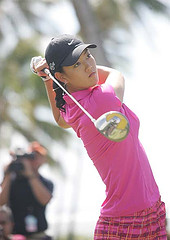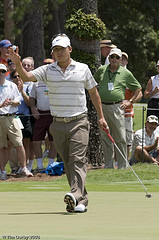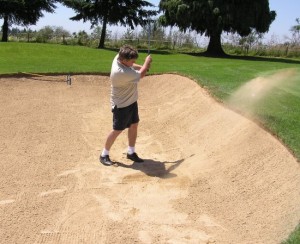Welcome to the 11th edition of Chip Shots—your friendly golf and grammar column. To read past versions, or to try and make sense of this nonsensical column, click here.
Today, I’d like to write a special Christmas edition of Chip Shots. But let’s be honest—do you really need your golf and grammar to be Christmasized (not a word, by the way)?
Of course not. So let’s get on with it.
Michelle Wie’s Rule Mishap
Michelle Wie recently earned her 2009 LPGA tour card. After a tumultuous 2008, congrats to Wie for bouncing back and having a stellar Q School.
Playing on such a grand stage at such a young age, Wie has often found herself mired in controversy—whether it’s about injuries, commitment, meddling parents, or rules violations.

Image: Cory.Lum/Flickr
One such rules situation occurred at the 2005 LPGA Samsung World Championship. Wie, then 16, illegally dropped after taking an unplayable lie on the 7th hole of the tournament’s third round.
Rule 20-7 outlines the proper procedure for taking an unplayable lie. The key point being—don’t drop the ball closer to the hole. Unfortunately for Wie, a Sports Illustrated writer, Michael Bamberger, witnessed Wie drop the ball about one pace closer to the hole.
Bamberger faced an unusual situation. He could act like it never happened, which I’m sure he contemplated overnight. Or he could be the reporter who influenced the outcome of a golf tournament. Neither appeared too desirable. But Bamberger was confident in what he witnessed.
Honest mistake by Wie, I’m sure. But, nonetheless, Wie later signed for a one under 71 and was later disqualified. She cried. She accepted blame. But, still, a tough situation for a 16 year old to go through so early in her career.
This situation received a lot of press several years ago. But, though it’s an old story, it deserves discussion here because it illustrates the importance of the drop.
If you’re in a tournament, remember Michelle Wie! No closer to the hole!
Affect Versus Effect
I think most people understand this one. But it’s a subject worth mentioning.
When do you use affect and effect? The quick answer is affect is a verb, and effect is a noun.
Affect means “to influence” something. An example: Cold, wet weather always negatively affects my golf game. Or Tiger Woods’ presence at a tournament affects television ratings.
Effect basically means “result.” Think of “cause and effect.” An example: What kind of effect do you think Tiger Woods comeback will have on the 2009 Tour season?
Simple enough. There are exceptions—aren’t there always exceptions? But that should cover the basics of affect and effect.
So there you have it. As always, send hate mail to robert.bruce@gameunderrepair.com.
Until next time…








